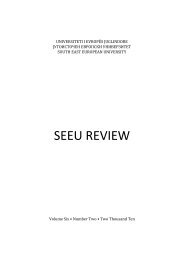SEEU Review vol. 5 Nr. 2 (pdf) - South East European University
SEEU Review vol. 5 Nr. 2 (pdf) - South East European University
SEEU Review vol. 5 Nr. 2 (pdf) - South East European University
You also want an ePaper? Increase the reach of your titles
YUMPU automatically turns print PDFs into web optimized ePapers that Google loves.
Murtezan Ismaili, PhD, Alajdin Abazi, PhD and Mile Srbinovski, PhD<br />
Abazi A., Srbinovski, M. & Ismaili, M., 2008; Ismaili M., Abazi A. &<br />
Srbinovski, M., 2009; Ismaili, M, Abazi A. & Srbinovski, M., 2009; Ismaili<br />
M., Abazi A., Srbinovski, M. & Zenki V., 2008; Srbinovski M, Abazi A. &<br />
Ismaili M., 2008).<br />
Many authors from all over the world are dealing with this problem. We<br />
will mention some of them: Hungerford et al. (1995), Bryant & Hungerford<br />
(1979), Forthner (1978), Bohl (1976), Jaus (1982), Wilson & Tomera<br />
(1980), Ramsey (1993), Culen (1994), Hoody (1995), Van Petegem &<br />
Blieck (2006), Dunlap & Van Liere (1978), Nooney et al. (2003) itn.<br />
Methodology of work<br />
The purpose of the research is (i) to estimate the level of environmental<br />
qualification of students from the Republic of Macedonia and (ii) to make a<br />
critical assessment of the current state of affairs. Beginning with the fact that<br />
the projection of perspectives in any teaching area is a complex process and<br />
requires extensive knowledge not only of the schools but also of the social<br />
conditions in which they are operating. Therefore, to fulfill all objectives the<br />
results of previous research were taken into consideration, such as (i) the<br />
analysis of the syllabuses, program and didactic material for all courses,<br />
classes in primary and secondary education, (ii) comparative analysis on the<br />
positioning of the formal EE in our country and in the world, (iii) the<br />
analysis on the chronological development of EE in our country and in the<br />
world etc.<br />
We assume that the level of environmental knowledge meets the<br />
criteria that emanate from the objectives and tasks of EE and most of<br />
the pupils are positively inclined towards the protection of the<br />
environment and are unsatisfied with the current state of affairs, in<br />
addition to being prepared to engage in its protection.<br />
In accordance with the objectives, we applied the following<br />
instruments: Test of environmental knowledge (TEK–1), Scale of<br />
values of environmental orientation (SV–2), Scale of satisfaction (SS–<br />
3), Scale of activity (SA–4), Questionnaire for students (QP-5) and<br />
Questionnaire for teachers/professors (PT/P-6). These instruments<br />
have been adapted from the literature (Srbinovski, 2005). 450 pupils<br />
from 8 secondary schools were included in the research.<br />
128

















